Top Rankings
Easton Area School District ranks among the top 20% of public school district in Pennsylvania for:
Category
Attribute
Diversity
Most diverse schools (Top 1%)
Community Size
Largest student body (number of students) (Top 1%)
For the 2025 school year, there are 8 public elementary schools serving 5,154 students in Easton Area School District. This district's average elementary testing ranking is 4/10, which is in the bottom 50% of public elementary schools in Pennsylvania.
Public Elementary Schools in Easton Area School District have an average math proficiency score of 27% (versus the Pennsylvania public elementary school average of 35%), and reading proficiency score of 47% (versus the 54% statewide average).
Minority enrollment is 60% of the student body (majority Hispanic), which is more than the Pennsylvania public elementary school average of 42% (majority Hispanic and Black).
Overview
This School District
This State (PA)
# Schools
9 Schools
2,145 Schools
# Students
7,978 Students
1,108,977 Students
# Teachers
582 Teachers
82,943 Teachers
Student : Teacher Ratio
14:1
14:1
District Rank
Easton Area School District, which is ranked within the bottom 50% of all 675 school districts in Pennsylvania (based off of combined math and reading proficiency testing data) for the 2021-2022 school year.
The school district's graduation rate of 82% has decreased from 89% over five school years.
Overall District Rank
#462 out of 684 school districts
(Bottom 50%)
(Bottom 50%)
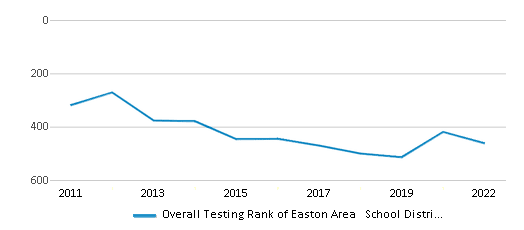
Math Test Scores (% Proficient)
29%
36%
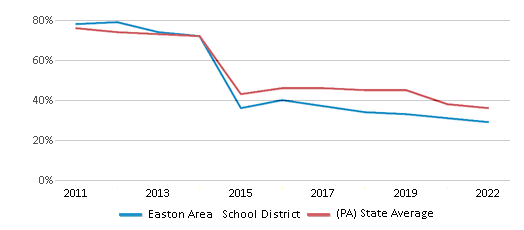
Reading/Language Arts Test Scores (% Proficient)
48%
55%
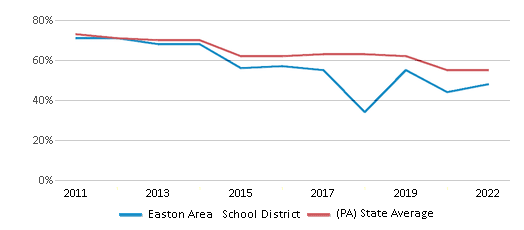
Science Test Scores (% Proficient)
49%
57%

Graduation Rate
82%
87%
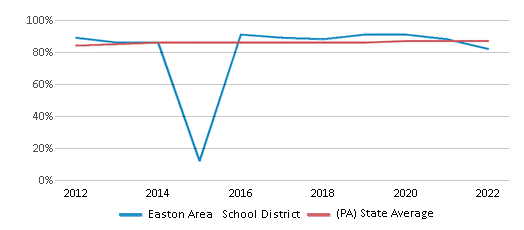
Students by Ethnicity:
Diversity Score
0.71
0.61
# American Indian Students
10 Students
2,278 Students
% American Indian Students
n/a
n/a
# Asian Students
407 Students
51,838 Students
% Asian Students
5%
5%
# Hispanic Students
2,602 Students
173,776 Students
% Hispanic Students
33%
16%
# Black Students
1,217 Students
169,696 Students
% Black Students
15%
15%
# White Students
3,201 Students
645,871 Students
% White Students
40%
58%
# Hawaiian Students
15 Students
965 Students
% Hawaiian Students
n/a
n/a
# Two or more races Students
526 Students
63,991 Students
% of Two or more races Students
7%
6%
Students by Grade:
# Students in PK Grade:
-
7,744
# Students in K Grade:
505
110,287
# Students in 1st Grade:
518
120,767
# Students in 2nd Grade:
572
126,133
# Students in 3rd Grade:
514
120,907
# Students in 4th Grade:
565
125,574
# Students in 5th Grade:
576
126,000
# Students in 6th Grade:
646
126,698
# Students in 7th Grade:
627
94,854
# Students in 8th Grade:
631
93,972
# Students in 9th Grade:
728
16,255
# Students in 10th Grade:
720
14,467
# Students in 11th Grade:
717
12,872
# Students in 12th Grade:
659
12,447
# Ungraded Students:
-
-
District Revenue and Spending
The revenue/student of $22,093 in this school district is less than the state median of $23,696. The school district revenue/student has stayed relatively flat over four school years.
The school district's spending/student of $23,469 is higher than the state median of $23,119. The school district spending/student has stayed relatively flat over four school years.
Total Revenue
$176 MM
$39,541 MM

Spending
$187 MM
$38,578 MM
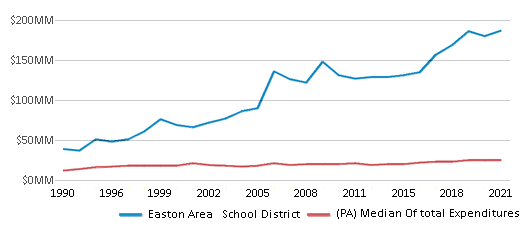
Revenue / Student
$22,093
$23,696
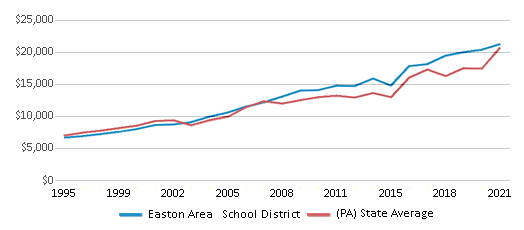
Spending / Student
$23,469
$23,119
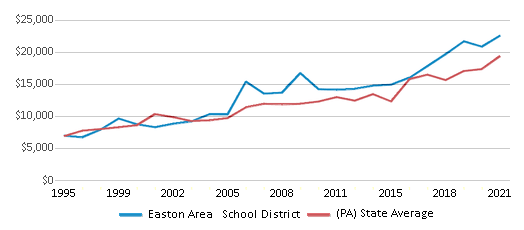
Best Easton Area School District Public Elementary Schools (2025)
School
(Math and Reading Proficiency)
(Math and Reading Proficiency)
Location
Grades
Students
Rank: #11.
Shawnee Elementary School
(Math: 55% | Reading: 71%)
Rank:
Rank:
8/
Top 30%10
1315 Echo Trail
Easton, PA 18040
(610) 250-2400
Easton, PA 18040
(610) 250-2400
Grades: K-5
| 557 students
Rank: #22.
Forks Elementary School
(Math: 50-54% | Reading: 55-59%)
Rank:
Rank:
7/
Top 50%10
1709 Richmond Rd
Easton, PA 18040
(610) 250-2536
Easton, PA 18040
(610) 250-2536
Grades: K-5
| 335 students
Rank: #33.
Palmer Elementary School
(Math: 47% | Reading: 57%)
Rank:
Rank:
6/
Top 50%10
3050 Green Pond Rd
Easton, PA 18045
(610) 250-2521
Easton, PA 18045
(610) 250-2521
Grades: K-5
| 541 students
Rank: #44.
Tracy Elementary School
(Math: 48% | Reading: 55%)
Rank:
Rank:
6/
Top 50%10
1243 Tatamy Rd
Easton, PA 18045
(610) 250-2556
Easton, PA 18045
(610) 250-2556
Grades: K-5
| 415 students
Rank: #55.
March Elementary School
(Math: 40-44% | Reading: 55-59%)
Rank:
Rank:
6/
Top 50%10
429 Reeder St
Easton, PA 18042
(610) 250-2531
Easton, PA 18042
(610) 250-2531
Grades: K-5
| 284 students
Rank: #66.
Easton Area Middle School
(Math: 16% | Reading: 45%)
Rank:
Rank:
2/
Bottom 50%10
1010 Echo Trail
Easton, PA 18040
(610) 250-2460
Easton, PA 18040
(610) 250-2460
Grades: 6-8
| 1,904 students
Rank: #77.
Cheston Elementary School
(Math: 14% | Reading: 30%)
Rank:
Rank:
2/
Bottom 50%10
723 Coal St
Easton, PA 18042
(610) 250-2542
Easton, PA 18042
(610) 250-2542
Grades: K-5
| 556 students
Rank: #88.
Paxinosa Elementary School
(Math: 16% | Reading: 22%)
Rank:
Rank:
2/
Bottom 50%10
1221 Northampton St
Easton, PA 18042
(610) 250-2551
Easton, PA 18042
(610) 250-2551
Grades: K-5
| 562 students
Recent Articles

What Is A Charter School?
Explore the world of charter schools in this comprehensive guide. Learn about their history, how they operate, and the pros and cons of this educational innovation. Discover key facts about charter schools, including admission policies, demographics, and funding, as well as what to look for when considering a charter school for your child.

10 Reasons Why High School Sports Benefit Students
Discover the 10 compelling reasons why high school sports are beneficial for students. This comprehensive article explores how athletics enhance academic performance, foster personal growth, and develop crucial life skills. From improved fitness and time management to leadership development and community representation, learn why participating in high school sports can be a game-changer for students' overall success and well-being.

February 05, 2025
Understanding the U.S. Department of Education: Structure, Impact, and EvolutionWe explore how the Department of Education shapes American education, from its cabinet-level leadership to its impact on millions of students, written for general audiences seeking clarity on this vital institution.





